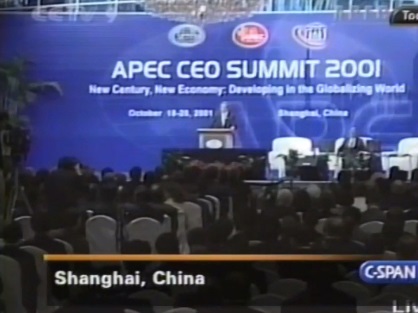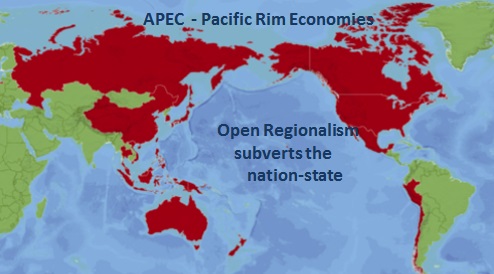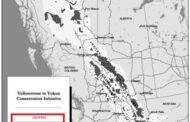In the first week in March of 2002, Attorney General John Ashcroft made a series of appearances to talk about the “war time reorganization” of the Department of Justice. The purpose of the reorganization as he characterized it was to change the mission from prosecution to prevention. September 11, 2001 provided the impetus. To prevent terrorism, the department had to shift it’s focus because terrorists plan to kill themselves in the act of their terrorism so prosecution after the fact has no purpose. Logic check that one. Ashcroft changed the operating mission for the entire Department of Justice for the model of the suicide bomber which was a phenomenon of the Middle East and in particular, between the Palestinians and Israelis.
The extraordinary meeting where Ashcroft made this announcement was held in Florida sponsored by the Florida Department of Law Enforcement and hosted by Mayor Glenda Hood of Orlando. At that meeting, Ashcroft explained his reorganization plan. Present at the event were Rep. Porter Goss (FL), Chairman of the House Permanent Committee on Intelligence, Senator Bob Graham (FL), Chairman of the Senate Select Committee on Intelligence, Michael Hayden, Director of NSA, John E. McLaughlin, former Deputy Director of the CIA, Robert Mueller, Director of the FBI, James Moore, Commissioner, Florida Law Enforcement, Ronald Noble, General Secretary of Interpol, VADM Thomas Wilson, Director of Intelligence, Joint Chiefs of Staff.
The following is a clip from that meeting. (The full program can be viewed on C-Span.) Ashcroft’s introduction was given by Lt. Governor Frank Brogan. Florida’s domestic security program was already in place and Brogan said it was a model for the entire nation. There is no doubt in this writer’s mind that what he said was true. Why? IBM was in Boca Raton and the domestic security program was all about information sharing. IBM was the leading corporation in the Alliance for Redesigning Government that was organized in 1992. Plus, the military – Southern Command was located in Florida – Dade County.
It’s noteworthy that Lt. Governor Frank Brogan was at the Emma E. Booker school with President George W. Bush on September 11th.
Florida was ready to mobilize in the event of a disaster. On September 7, 2001, Governor Jeb Bush signed Executive Order 01-261 giving statutory responsibility to the National Guard to support law enforcement and emergency management personnel in the event of civil disturbances, natural disasters and in countering drug operations. The EO delegated authority to the State’s Adjutant General to assist law enforcement with port security, training with local law enforcement and community-based organizations.
The next two speakers of interest were Rep. Porter Goss (FL), Chairman of the House Permanent Committee on Intelligence and Ronald Noble, General Secretary of Interpol. In Goss’ introduction of Noble, he said there was terrorism everywhere – all over the world. In fact, he tracked down Ron Noble to invite him to this event to talk about it.
Ron Noble’s remarks concerning the alleged terrorist planning documents found in Singapore combined with the idea of a global security system using shared information systems laterally (government-to-government) and vertically – national to local are key to understanding the coup d’etat and the deformation of the American government to serve global technocratic communism.
It’s also useful to know that the PECC International Secretariat is located in Singapore.
War on Terror
On September 20, 2001 in an address to Congress, President George W. Bush declared a War on Terror. He described some nebulous bogey men that wants to hurt the innocent. With the benefit of time and distance from the event of 9/11, listen to Bush’s speech – stripping out the emotional rhetoric.
How do you define terrorism? How do you define freedom? If you think that the answers to those questions are easy or obvious then you haven’t given serious thought to them. The search for answers begins with: What is the context within which the questions are being asked? That is the problem with John Ashcroft’s plan to upend the Department of Justice to focus on prevention of terrorism rather than prosecution of crime. There is a continuity of program planning and project progress beginning with the paradigm shift in the U.S. Transportation system that was initiated by the George H.W. Bush administration in 1990 (same year the PECC) was established. With the benefit of understanding that history, it makes John Ashcroft’s reorganization of the Justice Department an obvious next phase in the globalization of government. That view is fortified by the fact that there were three commissions on the prevention of terrorism completed just before Bush took office.
- +Three Commissions on Terrorism Prior to 9-11
Hart-Rudman Commission
The Commission was chartered in 1998 by Secretary of Defense William Cohen. The purpose was to do a full review of the U.S. national security organization and structure.
Phase I – New World Coming: American Security in the 21st Century, September 15, 1999
Phase II – Seeking a National Strategy, Apr 15, 2000
Phase III – Road Map for National Security: Imperative for Change, Feb 15, 2001
Air Force Magazine, April 2001, Hart-Rudman Calls for Homeland Defense “The commission predicts a direct attack on the United States”
Gilmore Commission
Congress directed the establishment of the panel in October 1998. The Department of Defense, in consultation with the Attorney General, the secretary of Energy, the secretary of Health and Human Services, and the director of the Federal Emergency Management Agency, contracted the RAND Corp. to support the group with a federally funded research and development center.
Secretary of Defense Williams S. Cohen announced formation of the advisory panel, headed by Virginia Governor James Gilmore, to assess domestic response capabilities for terrorism involving weapons of mass destruction (WMD). April 5, 1999
Gilmore Commission Panel Members
Commission Report 1 Assessing the Threat: Domestic Response Capability for Terrorism Involving Weapons of Mass Destruction, December 15, 1999
Commission Report 2, Toward a National Strategy for Combating Terrorism, December 15, 2000
Third Annual Report: To Assess Domestic Response Capabilities for Terrorism Involving Weapons of Mass Destruction, October 31, 2001
National Commission on Terrorism (Bremer Commission)
Report: Countering the Changing Threat of International Terrorism
National Commission on Terrorism chartered in 1999. Report delivered June 7, 2000.
Foreword written by L. Paul Bremer and Maurice Sonnenberg
“Six months ago, the National Commission on Terrorism began its Congressionally mandated evaluation of America’s laws, policies, and practices for preventing and punishing terrorism directed at American citizens.”
On February 14, 2003, President George W. Bush attended an event at which he stated explicitly that the reorientation of the Department of Justice was a phase of reinvention of government.
Bogor Goals
On October 20, 2001 at the APEC meeting in Shanghai, President George W. Bush gave a speech that to this writer reveals the context in which George W. Bush declared the War On Terror. The context in turn defines the characteristics of the “terrorists” outside of the religious context of Afghanistan. C-Span has a video of Bush’s remarks at that meeting and the transcript of the remarks are posted on the American Presidency website.
 Click on the image to bring up the video on C-Span
Click on the image to bring up the video on C-Span
The following are the specific things that George W. Bush said that reveal the context of 9/11 and they all have to do with trade facilitation which means transportation and integrated IT systems across borders:
The most visible part of our response is taking place in Afghanistan…My Government supports international efforts to bring help and stability and peace to that unfortunate nation.
There’s frustration about the delivery of food and medicine and help in Afghanistan.
Our war on terror has many fronts, and military action is only part of our plan. This campaign will take strong diplomacy and intelligence, diligent law enforcement and financial cooperation. It will span every continent and require varied contributions from many nations.
By attacking two great economic symbols, the terrorists tried to shatter confidence in the world economic system, but they failed. The terrorists hoped world markets would collapse, but markets have proven their resiliency and fundamental strength.
And this week in these halls, we return to the steady work of building the market-based economic system.
Together, we must meet the Bogor Goals, including free trade for every nation in this region by 2020. The Shanghai Accord we’ll sign tomorrow gives us new and useful tools to enhance trade and investment.
Even before September 11th, this region faced economic uncertainty. The answer is more trade and openness, not less. This region needs regulatory systems that attract investors. Banking systems must be more transparent. Corporations must be more open and accountable. And as called for in the Shanghai Accord, we must dramatically reduce the cost of doing business across borders by streamlining customs procedures, by harmonizing technology standards, and by cutting redtape.
Our second broad challenge is to fight terrorism within our countries without undermining the ties of commerce and friendship between our countries. Terrorists want to turn the openness of the global economy against itself. We must not let them. We need customs, financial, immigration, and transportation systems that make it easier for us to do our business and much harder for terrorists to do theirs. Pursuing both openness and security is difficult. But it is necessary, and it is the aim of the counterterror measures the APEC leaders will commit themselves to tomorrow.
Forceful Open Regionalism
When President George W. Bush mentioned the Bogor Goals in his remarks to APEC, he was committing to forceful open regionalism. In previous work, the progression of U.S. foreign policy was documented. The following are links to the significant documents that reveal the progression and the purpose:
- +Timeline of Open Regionalism and the Disintegration of the Nation-state
- 1980 – Pacific Economic Cooperation Council (PECC) is formed at the behest of governments.
1983 – Reagan signed the La Paz Treaty creating an international zone on our southern border with Mexico
1984 – Reagan announced the U.S. participation in the PECC
1989 – the Asia Pacific Economic Cooperation Council was formed with the U.S. participating at the founding, U.S. Trade Representative Robert Zoellick.
1991 – China joined APEC. President George W. Bush announced that his administration would pursue a trilateral free trade agreement linking the U.S., Canadian and Mexican economies.
1992 – The PECC issues a statement declaring support for open regionalism. The statement is known as the San Francisco Declaration.
1993 – President Bill Clinton convenes an APEC summit on Blake Island off the coast of Washington state. Output from the summit: APEC Leaders Declaration with Initiatives.
1994 – PECC meeting in Kuala Lampur issuing a Concord committing to unequivocal support for the San Francisco Declaration and a forceful movement for open regionalism (declaration of war against the nation-state) for the benefit global community.
1994 – APEC meeting in Bogor, Indonesia issuing the Economic Leaders’ Declaration of Common Resolve. Clinton kicked off the movement for a Free Trade Area of the Americas at a summit in Miami in 1994. The plan was to have a fully integrated region by 2005.
1995 – PECC meeting in Osaka, Japan. Prior to the meeting, PECC published a report titled, Implementing the APEC Bogar Declaration. The vision for APEC: APEC will be a new model of regional integration, quite different from the EU and NAFTA. “Recognizing the increasingly sophisticated nature of international economic transactions, the scope of trade and investment liberalisation in the Asia Pacific will go well beyond that of traditional Free Trade Areas (FTAs). APEC liberalisation of trade in goods and services will be supplemented by facilitation to dismantle all impediments to all international economic transactions as well as development cooperation programs.
Open regionalism is globalization. To achieve open regionalism means opening the borders without restrictions for foreign businesses, foreign workers, foreign products. In other words, open regionalism means ending the nation-state system of government.
Globalization and the end of nation-states obviously couldn’t be happening without the complicity of governments. From a logical standpoint, the economy can’t be globalized without globalizing government. If a government globalizes as the U.S. government has done, it ceases to be a government for the people of the nation and in fact, it becomes a hostile foreign occupation authority which is consistent with the government’s hostility towards American patriots. Patriots are by definition nationalists and nationalists would be the enemies of a foreign occupation authority as the U.S. government has become. The current debate on border protection clearly delineates the two sides. The hostile foreign occupiers (even if citizens) are globalists who want the borders open and the patriots are nationalists who want our borders guarded to prevent foreign invasion. It couldn’t be more clear than that.





